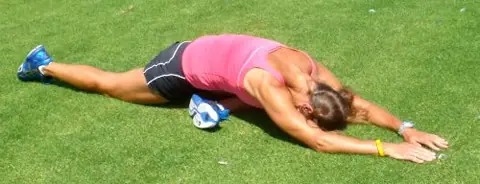Tennis is a demanding sport on your muscular-skeletal system. The quick direction changes and bursts of sprints and stops are extremely taxing to your muscles, tendons and joints.
The one-sided aspect of the game creates even more problems -- the dominant side of your body gets much more work, even if you play a two-handed backhand, because you hit the serve, volleys and forehands with your dominant side only.
Tennis Events Near You
The majority of players also prefer to hit forehands and they run around backhands as much as they can, which will add even more work to the dominant side.
Over time, one side of your body gets stronger, bigger, and tighter. No amount of work in the gym will make it even, but it is a good idea to work hard to make the difference as little as possible.
In addition to changes in your upper body, there are things happening in your hips.
When you choose to hit forehands instead of backhands, you hit the forehands with the open stance most of the time, while many backhands you hit with the closed stance, and therefore the hip muscles of your dominant side work much more.
Once you start having slight imbalances in your hips, then the mechanics of your running stride change a little bit and over time, you may encounter problems with the knees, ankles, feet, or the lower back.
Paying attention to your hips should become a high priority in your fitness training. Keep them balanced with strengthening and stretching and always address one side at a time so you can feel the imbalances.
After every tennis practice or fitness training, you need to stretch the hips and glutes. If your training have caused any hip issues, you can correct them right then, before the muscles get tight and make the imbalances even worse.
Perform this glute stretch after every training session, and preferably daily.
Glute Stretch

1. Get down on the ground on your hands and feet with your glutes up in the air.
2. Bend the left leg and bring your knee and the lower leg forward on the ground close to your hands. If you are very flexible, your lower leg will be parallel with your hands. If you are like most tennis players, your foot will be closer to your hip.
3. Slowly fold down your upper body over the left leg, place your elbows on the ground, and relax your shoulders and the right leg. Do not tilt your hips to the left; keep them parallel with the ground.
The goal is to touch the left hip to the ground, but through the flexibility of the muscles in the hip rather then tilting your hips.
4. Relax your neck and make yourself comfortable in the stretch.
The majority of tennis players find this stretch difficult because of the tightness in the glutes. You may also feel tightness in your left inner thigh, knee or the right hip flexor.
5. Breathe deeply and hold the stretch for 1-2 minutes, then switch sides. Always start with the tighter side, then stretch the good side and return to the tighter side one more time.
With regular practice, you will be able to keep the hips parallel, while your butt cheek is comfortably resting on the ground.
Daily stretching and myofascial release of your glutes will keep your hips functional, and as a result, your movement on the tennis court will be faster and more explosive.
You will get to the balls sooner, hit shots that are more powerful, and your tennis game will improve. You can find a complete tennis stretching routine for after your practice at TennisFitnessLove.com.


